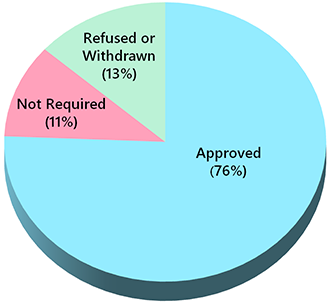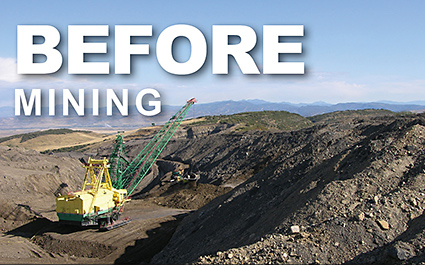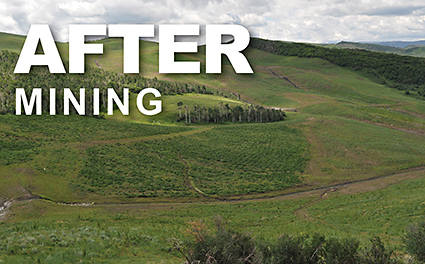Other Industrial Sectors
Mining and oil and gas developments affect less area than forestry and agriculture but often have the highest intensity of impact. Ecological integrity drops to zero in an open-pit mine. Because the disturbances created by these industries have no natural analog, the natural disturbance model is of little utility here. Nor is there an overarching sustainability framework with broad institutional support. Instead, conservation is narrowly applied on a project-by-project basis through environmental impact assessments, operating regulations, and reclamation.
The management philosophy is (1) minimize ecological damage at the time of construction, when most disturbance occurs; (2) minimize on-site and off-site impacts during the operating phase; and (3) restore the site once production has ceased. The working assumption is that the impacts on biodiversity will be transient, given that the disturbances are temporary and affect a relatively small amount of the land base.
A major shortcoming of this management approach is that it does not account for cumulative effects (Franks et al. 2013). The time period between construction and reclamation is long (i.e., decades), so new disturbances are added before old ones have recovered. Moreover, reclaimed sites in forested areas are typically replanted to grass instead of being reforested. Access roads are rarely reclaimed, and abandoned mines and wells are a perennial problem. Consequently, even if individual disturbances are small, the cumulative industrial footprint and its ecological effects can become significant over time (Nitschke 2008). Most jurisdictions in Canada have struggled when it comes to the management of these sorts of cumulative disturbances.
Environmental Impact Assessment and Mitigation
Anthropogenic disturbances with no natural analog, such as open-pit mines, oil wells, hydroelectric dams, roads, and seismic lines are typically managed through the direct mitigation of known environmental effects. Small disturbances and routine developments like access roads and well sites are managed through standardized regulations that typically have only rudimentary provisions for biodiversity conservation. For example, regulations governing the construction of access roads usually include measures to reduce soil erosion, but they fail to address the issues of habitat fragmentation and human access.
The environmental effects of larger projects, such as mines and hydroelectric dams, are addressed through formal environmental impact assessments, as directed by legislation at both the federal and provincial levels. Although each jurisdiction has its own procedures, the basic steps in the assessment process are similar across the country (Connelly 2011). Projects are first screened to determine if a formal assessment is needed. The issues of concern are then identified and assessed.
Environmental assessments are concerned with “valued ecosystem components,” which vary from project to project (Connelly 2011). The identification of valued ecosystem components is a government responsibility and usually incorporates the values and priorities of government departments, Indigenous communities, stakeholders, and the public. Biodiversity is just one of many valued components that are examined. Components related to human health (e.g., water and air quality) and ecosystem services (e.g., tourism and Indigenous cultural use) tend to be emphasized.
The effects of a project on valued ecosystem components are assessed through selected indicators. Biodiversity indicators are typically high-profile focal species and there is often little consideration of the impacts of a project on overall biodiversity (e.g., Noble et al. 2016).
Once the indicators have been selected, the effects of the various types of disturbance created by the project are quantified (GOBC 2013). Ideally, these outcomes are expressed in the form of quantitative indicator-specific models that:
- Account for both direct and indirect effects of project-related disturbance on the indicator
- Account for both immediate and long-term effects of project-related disturbance
- Describe project-related indicator changes in the context of natural baseline conditions (i.e., account for any pre-existing deterioration in the indicator)
- Incorporate interactions with other factors known to influence the status of the indicator, including other existing and proposed developments
- Provide an estimate of the uncertainty associated with the predictions
In practice, cumulative effects, interactions among disturbances, and scientific uncertainties tend to be poorly addressed (Duinker and Greig 2006; Jones 2016). In part, this is because project proponents are responsible for the research and analysis, and they view the assessment process as a barrier to be overcome as expeditiously as possible. More generally, individual companies lack the planning capacity, baseline data, and accountability for land management that would contribute to a comprehensive assessment (Fig. 7.13). There is also a general lack of guidance concerning desired regional outcomes, other than the abstract notion of sustainable development. It has long been recognized that a regional approach to assessment is needed to improve project reviews (CCME 2009). This is a topic we will turn to later in the chapter.
 |
Fig. 7.13. Oil and gas leases are typically one section (1.6 km2) in size. In this example from northeast Alberta, there are 33 companies operating across an area of nine townships (each company is a different color). These companies are poorly positioned to manage cumulative effects because each has only a small window into the changes that are occurring across the entire landscape. |
Assessments must also identify mitigation measures to prevent the potential adverse effects of the project or to reduce them to an acceptable level. Mitigation measures involving project design are particularly important because most land disturbance occurs at the time of initial construction. Efforts can be made to minimize the area disturbed and to avoid disturbing areas of high conservation value. In some cases, mitigation may involve offset measures, in which unavoidable impacts are balanced with restoration efforts in other areas, resulting in no net loss (Noga and Adamowicz 2014). This approach is used in the US but is uncommon in Canada. Environmental impacts that cannot be mitigated are known as residual effects, and they must be described in terms of likelihood, significance, duration, and reversibility.

Based on the proponent’s analysis of potential impacts and proposed mitigation measures, the government makes a ruling. In practice, only a small percentage of projects are rejected because the environmental impacts are unacceptable (Fig. 7.14). In most cases, the benefit of the assessment process is in the mitigation measures attached to the approval. To be clear, there is no requirement that all impacts must be mitigated. Approval simply implies that the societal benefits of the project outweigh the environmental risks. This is ultimately a political decision.
Reclamation
When decommissioning industrial projects, resource companies must meet specific reclamation requirements defined in various environmental protection statutes and policies, mainly at the provincial level (Valiela and Baldwin 2007). For smaller projects, like individual well sites, operators are usually required to return the site to an equivalent land capability, rather than restore it to the way it was before disturbance (GOA 2016). In practice, this has generally meant planting sites back to grass (Osko and Glasgow 2010). For larger projects, such as mines, companies are usually required to develop detailed reclamation objectives in consultation with local communities and other stakeholders. Achieving equivalent land capability is again the norm (Fig. 7.15), and an emphasis is typically placed on addressing human health concerns.
 |
 |
| Fig. 7.15. Mining operations are required to reclaim sites back to original land capability. This example illustrates a coal mine during operation and after reclamation. Note that the site has been restored to grass, not forest. Credit: Peabody Energy. | |
For projects subject to an environmental impact assessment, a formal Closure and Reclamation Plan is normally required (INAC 2007). This plan must demonstrate how the site is to be reclaimed and describe the likely residual risks to human health and the environment. The plan must demonstrate that the knowledge and expertise needed to recreate geochemical, hydrological, and ecological processes, within desired bounds, are available (Johnson and Miyanishi 2008). Companies must also demonstrate that the financial resources for reclamation will be available when required. The overall feasibility of the proposed reclamation program and the seriousness of residual effects are both considered in the project’s environmental impact assessment.
The provision of adequate funding for reclamation has been a perennial problem in Canada and elsewhere. Governments are often reluctant to force companies to provide full closure costs up front because this often makes resource projects financially unviable (Cowan et al. 2010). As a result, many companies have been able to circumvent their obligations. There are now an estimated 10,000 abandoned mine sites in Canada, requiring varying degrees of rehabilitation (Castrilli 2010). Abandonment is also a problem in the oil and gas sector. In Alberta, the number of inactive wells awaiting closure has increased from 35,000 in 2000 to 87,000 in 2019, and over 1,700 have been abandoned without reclamation (AER 2020; OWA 2022). Government-industry programs have been established to rehabilitate these abandoned mines and wells, but progress has been slow (Castrilli 2010).

